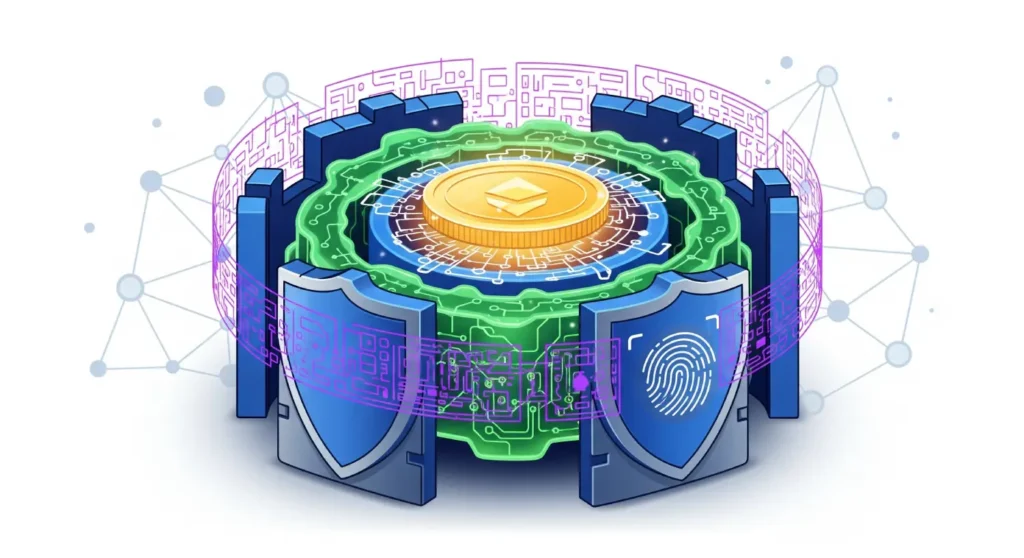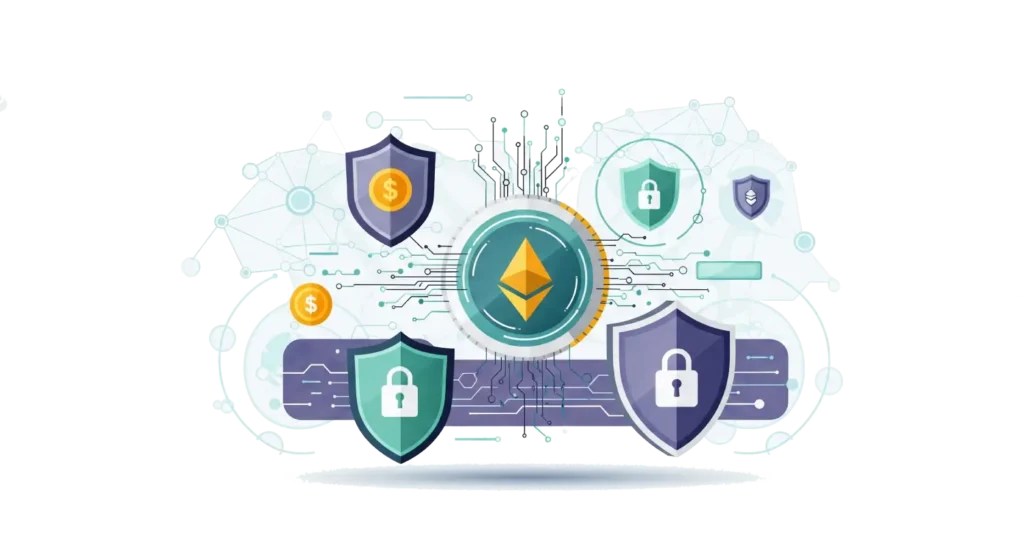
🤔 Is there truly a “best” way to secure your crypto?
The answer is: no. In the world of cryptocurrency, there is no single, universal, or everlasting security solution. What seems like the best crypto security today might become outdated or vulnerable tomorrow, as technologies and attack methods continuously evolve.
It’s important to understan that “best” security doesn’t mean absolute or total protection — instead, it’s about a comprehensive approach: combining various tools and practices tailored to your specific needs and risk level. No one can say with 100% certainty which strategy is the safest right now.
However, adopting a multi-layered defense—such as hardware wallets, cold storage, multi-factor authentication, regular monitoring, and caution against phishing attempts—can significantly reduce the risk of loss or hacking.
In this article, we don’t claim to have a magic formula but explore different strategies and best practices to help you build a stronger security system for your digital assets. 🛡️
📌 Key Takeaways
- ✅ Layers of Defense: Combine multiple security methods for robust protection.
- ✅ Battle-tested: Choose protocols that have proven their long-term security.
- ✅ Multisig and Air-Gapped: Use multisignature wallets and air-gapped devices for enhanced protection.
- ✅ Smart Habits Matter: Strong passwords, 2FA, and phishing awareness are as critical as the technology.
- ✅ Decentralization is Key: Protocols with widespread networks are inherently more secure.
- ✅ No Guarantees: Even the best security cannot eliminate all risks, including market volatility.
1. Building Crypto Fortress: Layered Protection
Think of your crypto security as a fortress you build to protect your digital wealth. 🏰 A single lock isn’t enough—you need multiple layers of defense, each reinforcing the next.
This is the core idea behind “best” crypto security: layered protection. If one layer somehow fails, other layers are there to catch it. This makes it much harder for attackers to get to your digital money.
- Beyond Technology: It’s more than just fancy computer code. Your security fortress has walls made of smart technology, like blockchain and cryptography. But it also has walls built from your own smart habits and choices. 🧠
- Combining Defenses: We will look at how these different parts work together. From where you store your crypto to how you access your accounts, to the very design of the crypto itself.
- Why Layers Work: Imagine a thief trying to get into your fortress. They might get past the first gate. But then they face a second gate, and then a guard, and then a strong vault. Each step makes it harder. This multi-layered approach creates a much stronger defense against all kinds of threats. 💪
2. What is the most secure place for crypto?
There is no single “most secure” place for cryptocurrency. This is because the security landscape is constantly evolving, and the right choice depends on your specific needs, such as the amount you own and how often you use your assets. The gold standard for security is keeping your private keys offline in air-gapped systems. This section explores your options to help you choose the right crypto wallet. 🏦
2.1. Hardware Wallets (Cold Storage) 🔒
- 🛡️ Offline Protection: These physical devices store your private keys offline, making them nearly immune to online hacks.
- 🔐 Physical Security: Protect the device and its seed phrase. Store them separately in secure locations, like fireproof safes. If lost, your seed phrase is your backup to recover funds.
- Long-Term Tip: For years-long storage, consider multi-signature wallets (e.g., 2-of-3) to simplify inheritance. Every 2–3 years, check that your wallet supports current blockchain standards to avoid obsolescence.
2.2. Software Wallets (Hot Wallets) 🔥
- 💻 Online Access: These wallets run on your computer, phone, or browser, offering convenience for daily use.
- ⚖️ Convenience vs. Risk: Hot wallets are suitable for small amounts but are vulnerable to hacks due to their internet connection.
- 📱 Types:
- 🖥️ Desktop Wallets: Programs installed on your computer.
- 🤳 Mobile Wallets: Apps on your smartphone.
- 🌐 Browser Wallets: Extensions for your web browser.
📚 Related Reading: Explore our guides: Hardware vs Software Wallet: Which One Is Safer?
2.3. Paper Wallets 📄
- 🖨️ Physical Printout: Your private and public keys printed on paper, kept offline.
- ⚠️ High Risk: Easy to lose, damage (e.g., fire, water), or steal. Not recommended due to physical vulnerabilities.
2.4. Exchange Wallets (Custodial) 🏦
- 🤝 Third-Party Held: When you keep crypto on an exchange, the exchange actually holds the private keys for you. You don’t directly control your crypto. This is called “custodial” storage.
- ⚡ Convenience: Exchanges are very easy to use for buying, selling, and trading crypto quickly.
- 🎯 Centralized Risk: However, they represent a “single point of failure.” If the exchange is hacked, goes bankrupt, or faces legal issues, your crypto could be at risk. This is why the phrase “Not your keys, not your crypto” is so important. You are trusting a third party with your funds.
📚 Related Reading: Explore our guides: Custodial vs Non-Custodial Wallets – What’s the Difference?
2.5. Air-gapped Systems
• 🌐 What Are They?: An air-gapped system is a computer or device never connected to the internet, used to sign transactions offline.
• 🛡️ How It Works: Create a transaction on a connected device, transfer it via USB or QR code to the air-gapped device, sign it with your private key, and transfer it back for broadcasting. Tools like Electrum or Sparrow Wallet support this.
• ✅ Pros: Virtually immune to online attacks, ideal for large, long-term holdings.
• ⚠️ Cons: Requires technical expertise and secure physical storage (e.g., in a safe). Mistakes can lead to fund loss.
• 📝 Recommendation: Use a dedicated device with a clean OS (e.g., Ubuntu Live USB) and store it securely. For most users, a hardware wallet offers similar security with less complexity.
📚 Related Reading: Explore our guides: Air-Gapped Protection for Beginners
For those looking to take their crypto security even further, running a personal blockchain server (full node) can enhance your control and privacy by independently verifying transactions. Learn more in our guide: Why a Blockchain Server is Essential to Boost Crypto Security.
3. What is the most secure crypto account?
There is no single “most secure” crypto account. True security is built by following a combination of best practices. It starts with taking full control of your private keys and protecting them with strong passwords, two-factor authentication (2FA), and proactive security habits. This section covers how to lock down access to your crypto. 🔐
3.1. Strong, Unique Passwords 🔑
- 🚫 Never Reuse: This is a golden rule. Every single crypto-related account (exchanges, wallet interfaces, email linked to crypto) needs a different, complex password. If one account is breached, others remain safe.
- 📏 Complexity: Use a mix of uppercase and lowercase letters, numbers, and symbols. Aim for at least 12-16 characters.
- 📝 Password Managers: Consider using a reputable password manager (e.g., LastPass, 1Password). These tools create and store strong, unique passwords for you, making your life easier and safer.
3.2. Two-Factor Authentication (2FA) ✅
- ➕ Extra Layer: 2FA adds a second layer of security beyond just your password. Even if someone steals your password, they still need this second factor to get in.
- 📱 Authenticator Apps: Use authenticator apps like Google Authenticator or Authy. These apps generate time-sensitive codes. They are much more secure than SMS (text message) 2FA, which can be vulnerable to “SIM swap” attacks.
- 🔑 Hardware 2FA: For a more robust form of 2FA security, consider a physical security key (like a YubiKey). You must physically plug this device in or tap it to log in. This is extremely difficult for attackers to bypass.
3.3. Whitelisting Addresses 📝
- ✅ Pre-Approved Destinations: Many exchanges and some wallets allow you to “whitelist” (pre-approve) specific crypto addresses for withdrawals.
- 🛑 Prevents Unauthorized Sends: If your account somehow gets hacked, the attacker can only send funds to these pre-approved addresses. This acts as a powerful safety net, preventing unauthorized transfers to unknown wallets.
3.4. Regular Security Checks 🕵️
- ⚕️ Device Health: Keep your computer and smartphone clean from malware. Run regular antivirus scans. Be careful about what software you install.
- 🔄 Software Updates: Always keep your operating system (Windows, macOS, iOS, Android), web browsers, and crypto wallet software updated. Updates often include critical security fixes for newly discovered vulnerabilities.
- 🎣 Phishing Awareness: Stay vigilant against phishing attempts. Always double-check URLs, email senders, and be wary of unsolicited messages.
- 🚫 Public Wi-Fi Caution: Avoid accessing your crypto accounts or wallets on public Wi-Fi networks. These networks are often unsecured and can be easily monitored by attackers.
📚 Related Reading: For practical steps to implement these account security measures, see our guide: How to Secure Crypto for Beginners: Step-by-Step Guide.
4. What is the Most Secure Crypto System? 🌐
When we talk about the “most secure” crypto system, we mean a blockchain protocol that resists attacks, maintains integrity, and supports long-term reliability. Security depends on factors like decentralization, consensus mechanisms, network size, and code quality.
While no system is immune to all risks, cryptocurrencies like Bitcoin and Ethereum are often cited as a benchmark for security due to their robust designs. This section explores the principles that make a crypto system secure and helps you identify resilient options for long-term use.
4.1. Decentralization 🌐
Think of it as a book stored in thousands of libraries worldwide. If one library is attacked, the book (your crypto’s data) remains safe in others.
- 🔗 Spread Out Power: Decentralized networks, with nodes worldwide, have no single point of failure.
- 💪 Resilience: Bitcoin and Ethereum’s vast networks make them highly resistant to attacks.
4.2. Consensus Mechanism ⛏️
This is like a voting system where all network participants agree on the correct record of transactions, ensuring no single party can cheat.
- 📝 Agreement Rules: Ensures all nodes agree on transactions.
- Proof of Work (PoW): Bitcoin’s energy-intensive mining makes attacks costly.
- Proof of Stake (PoS): Ethereum’s staking penalizes bad actors, enhancing security.
4.3. Network Size & Age 👴
- 🛡️ Battle-Tested: Older networks like Bitcoin have faced and fixed numerous threats.
- 👀 Community Scrutiny: Large developer communities spot vulnerabilities faster.
4.4. Code Audits & Bug Bounties 🐛
- 🔍 Reviewed Code: Reputable projects undergo independent audits.
- 🎁 Rewards: Bug bounties encourage ethical hackers to report issues.
4.5. What is the Safest Crypto for Long-Term Use? 📈
It’s impossible to definitively name the “safest” cryptocurrency for long-term use due to rapid shifts in technology and security. Instead, long-term security is achieved by combining a battle-tested protocol with robust storage practices. While no single cryptocurrency is universally “the safest,” established systems like Bitcoin and Ethereum are considered secure due to their proven resilience and network effects. This section will show you how to identify and protect secure cryptocurrencies for your long-term goals.
- ✅ Robust Protocol: Choose cryptocurrencies with strong, time-tested protocols. Prioritize projects with:
- Open-Source Code: Enables community scrutiny to catch vulnerabilities, as seen in Bitcoin and Ethereum.
- Regular Security Audits: Ensures independent experts verify the protocol, a practice common in top projects.
- High Market Capitalization: Cryptocurrencies like Bitcoin or Ethereum, with over $10 billion in market cap, have more resources for security and stability.
- Active Development: A dedicated team with frequent updates, like Ethereum’s ongoing upgrades, ensures resilience against new threats.
- 🌐 Protocol Resilience: Opt for highly decentralized networks with strong consensus mechanisms (e.g., Bitcoin’s PoW or Ethereum’s PoS). Bitcoin, for example, is often considered the gold standard for security due to its massive, decentralized network and 15+ years of attack resistance.
- 🔒 Secure Storage: Use hardware wallets or air-gapped devices for cold storage to keep private keys offline, protecting them from hacks. Choose self-custody to avoid exchange risks like hacks or bankruptcy. Store your seed phrase on a fire- and water-resistant metal plate in multiple secure locations, like a safe and a bank vault. Never store it digitally.
- 🔐 Advanced Protection: Consider multisignature (multisig) wallets, which require multiple keys to authorize transactions, adding an extra layer of security for high-value holdings.
- 🧠 Your Role: Even the most secure crypto system can be compromised by poor habits. Use strong, unique passwords, enable 2FA, and stay vigilant against phishing scams.
By combining a robust protocol like Bitcoin’s with secure storage and vigilant habits, you can build a near-unbreakable system for long-term crypto safety.
📚 Related Reading: Dive into What Is Blockchain and How Does It Work? and What Makes Blockchain Secure?
5. Frequently Asked Questions
Q1: Which crypto has the best security?
A: There is no single cryptocurrency that has “the best” security. Instead, a crypto’s security is built upon a combination of key factors such as decentralization, a battle-tested protocol, and active development. For these reasons, established systems like Bitcoin and Ethereum stand out as noteworthy examples of secure networks.
Q2: What is the most secure crypto system?
A: There is no single “most secure” crypto system. Instead, the security of a system is determined by the robustness of its core components. Key factors include a strong, battle-tested protocol, robust consensus mechanisms (such as PoW or PoS), and continuous code audits. Systems like Bitcoin and Ethereum are often cited as examples that have these strong security foundations.
Q3: What is the most secure place for crypto?
A: There is no single “most secure” place for all crypto, as the right security practice depends on your specific needs. However, for a truly high level of security, the gold standard is keeping your private keys offline in air-gapped systems. This method significantly reduces the risk of your keys being exposed to an internet-connected device, providing a robust defense against online threats.
Q4: What is the most secure crypto account?
A: There is no single “most secure” crypto account. Instead, security is built upon a combination of best practices and personal control. The most fundamental step is to use a non-custodial wallet where you are in full control of your private keys. You can then enhance this security with measures like strong passwords, app-based two-factor authentication (2FA), and address whitelisting.
Q5: What is the safest crypto for long term use?
A: There is no single “safest” crypto for long-term use. Instead, security is achieved by combining a time-tested protocol with robust storage practices. For these reasons, storing assets like Bitcoin and Ethereum in a hardware wallet with a multi-signature setup for inheritance is considered a top-tier approach for long-term protection.
🎯 Conclusion
So, what is the “best” crypto security? 🤔 As we’ve seen, there’s no single, universal answer. It’s not about one crypto being inherently “unhackable” or one wallet being magically foolproof.
Instead, the strongest security comes from a powerful combination:
- 🛡️ Robust Technology: Choosing cryptocurrencies with strong, decentralized, and battle-tested protocols.
- 🔒 Smart Storage: Opting for cold storage (like hardware wallets) for significant, long-term holdings.
- 🧠 Vigilant Habits: Practicing strong password hygiene, using advanced 2FA, and staying aware of common threats.
You have the power to make your crypto journey safer. By understanding these layers and applying them diligently, you can build a personalized security strategy that provides protection for your digital assets. Your crypto’s safety is ultimately in your hands. 🚀
Take control of your crypto security today! Dive deeper into protecting your assets by exploring our guides on choosing the right wallet or understanding blockchain security.
Start building your crypto fortress now!

